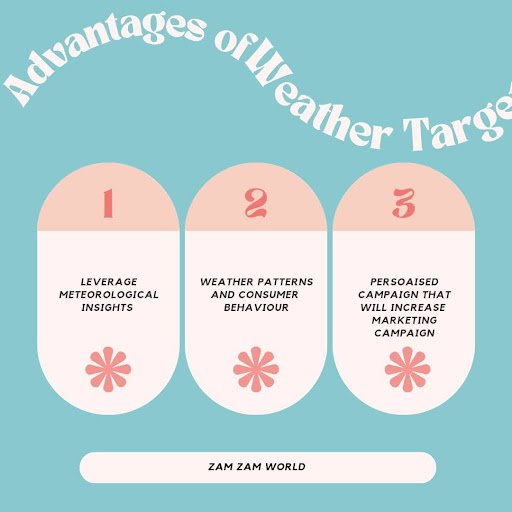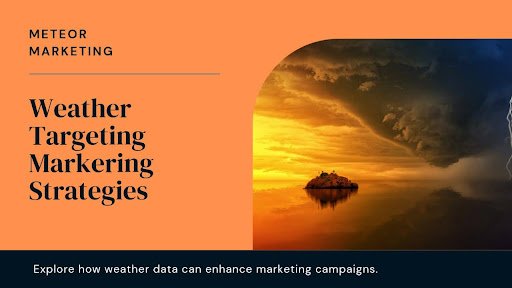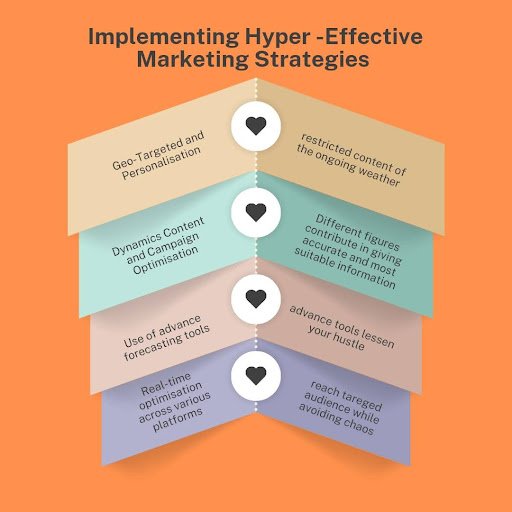Table of Contents
Share This Article :-
In the consistently developing scene of marketing, remaining on the ball is central. One such imaginative methodology for getting forward movement is weather targeting. After the state of the economy, weather stands as the second most influential factor on consumer behavior.
Envision fitting your promoting endeavours in view of socio-economics or interests, yet additionally on the ongoing weather conditions. This is where atmospheric precision comes into play, offering a strategic edge that can significantly enhance engagement, conversion rates, and overall ROI.
In this blog, we will deeply study why our marketing needs to be aligned with weather. What are different weather targeting strategies, examples, and how we can implement them in our strategies?

What is Weather Targeting?
Weather targeting, generally, includes utilising climate information to tweak promoting systems and missions. It’s tied in with understanding how different weather conditions impact consumer behaviour and changing your methodology. Weather targeting uses real-time data and delivers righteous marketing tactics as per location, needs, and demands.
By taking advantage of meteorological experiences, organisations can make more important and convenient showcasing messages that reverberate with their ideal interest group.Another name for weather targeting is weather triggering. Utilising weather targeting enhances relevance by leveraging real-time data to tailor ads more effectively, resulting in significant improvements in conversion rates.
In cold areas, clothing retailers target consumers with coats, leather materials, and winter shoes to keep them warm.
Understanding Weather Targeting: How Weather and Advertising Can be Linked?
Weather not only brings changes in our living style but our emotions observe changes too. The weather has a large impact on human life.
Weather can not only impact one’s daily life and activities, but it also is a huge driver of emotions. A notable portion of individuals report heightened feelings of sadness during winter months or rainy weather. Approximately 5% of adults in the United States grapple with seasonal affective disorder (SAD), while a larger segment experiences a milder variant termed “winter blues.” Despite the acknowledgment that emotions influence purchasing decisions, the impact of weather on mood and consumer enthusiasm is frequently underestimated.
For Example :
Weather influences people’s preferences accordingly. In summer, coms, users mostly look for light weight clothes. As an advertiser, you should remember where to advertise and which stuff to advertise. You can’t advertise winter clothes in the June-July months in India or Pakistan. As there are summers in both of these countries temperature may vary from 38 – 47 degrees. You can create converting campaigns by using location data and weather retargeting.
Advantages of Weather Targeting
The advantages of weather targeting are multifold. Firstly, it improves significance and commitment by conveying content that lines up with customers’ nearby encounters. Also, it prompts higher transformation rates as customised messages are bound to incite activity. Finally, it improves ROI by optimising marketing spend based on real-time weather insights.

1. Leveraging Meteorological Insights
Key to targeting weather conditions is the usage of constant and authentic climate information. This incorporates temperature, mugginess, precipitation, and other important measurements. By coordinating climate APIs, organisations can get precise and modern data, empowering them to pursue informed choices in their promoting efforts.

2. Weather Patterns and Consumer Behavior
Research has shown that weather conditions altogether impact buyer conduct. For example, on hot days, individuals might be more disposed to buy reviving refreshments or open-air gear. On the other hand, during colder climates, comfortable indoor exercises or solace food might be more alluring. Understanding these patterns allows marketers to tailor their messaging and offers accordingly.
Example: How consumers’ mood led them to buy certain things

3. Personalised Campaigns will Increase your Marketing Campaign
66 % companies have to understand the unique needs of consumer’s demands.55% companies are paying attention to consumers’ preferences. Individual campaigns are trending and most influential these days.
Weather-triggered advertising is the most advantageous for your company’s ROI. By precisely targeting customers based on their current context, you can expect to see improvements in leads, conversions, and customer retention. Research indicates that companies with well-defined marketing-led personalization functions are 38% more likely to achieve an ROI of 400% or higher compared to those without such capabilities.
Weather Targeting Marketing Strategies

1. Use Seasonal Forecasts to design your next advertisement while looking into regional perceptions
While preparing for a campaign have a deep look into historical weather and forecasts. It will guide you in the process of advertisement. When you have to align it and make changes according to the weather.
People living in different areas have different perceptions related to weather and they buy accessories accordingly. For example: When temperature drop to 50 degrees in Northern states people prefer consider it as spring barbecue. On the other hand in Florida, people consider buying jackets. assessed the anticipated weather conditions for your campaign duration, you can align product placement, messaging, and targeting strategies accordingly.
2. Use of historical and live weather data
1. Historical Weather Data
Weather is the most important channel in consumer’s decision-making. Past climate patterns can be well known by historical weather data. You can compare the current condition with provisous years easily while studying historical weather data.
For example:
Sears Automotive utilizes historical data to ascertain that car batteries older than five years tend to fail following three consecutive days of sub-zero temperatures. Consequently, they initiate weather-triggered advertisements on the fourth day of freezing temperatures.
You can easily figure out the demand for certain products by keeping in view historical weather data which will definitely align your thoughts while creating multiple future marketing plans.
2. Live Weather Data
You will get real-time live updates by Live weather data. Live weather updates can be a great asset for marketing,
Real-time weather updates can prove invaluable for marketing, particularly for industries heavily influenced by weather conditions, such as outdoor events, agriculture, travel, and retail.
This data type enables the adjustment of ad campaigns in real-time, allowing businesses to capitalize on short-term opportunities with minimal effort. By incorporating live weather updates into their marketing strategies, businesses can enhance customer engagement, increase sales, and better meet the needs of their target audience. You can capitalize on short-term opportunities from live weather data.
3. Use advanced forecasting tools
You can use different tools that provide a user-friendly interface that will simply establish your marketing startup. Look into platforms for advanced tools. But you are thinking why?
You will get advanced and detailed insights without much hustle. The data you will get will be fruitful in understanding consumers’ behaviour, needs, responses and helps in filtering marketing strategy.
4. Real-time optimisation across various platforms
Multi-platform optimisation leads to reaching the targeted audience while avoiding chaos. This includes messaging and sending updates to your audiences. Real-time optimisation across various platforms such as Meta, Tiktok, Facebook, Google Ads, etc perfect for optimising your marketing campaign.
For example:
On a sunny day, businesses might deploy a series of beachwear ads on Instagram, while simultaneously offering discounts on cold beverages through Google Ads to capitalize on the weather conditions.
Implementing Hyper-Effective Marketing Strategies

1. Geo-Targeting and Personalization
Geo-targeting allows advertisers to convey restricted content in view of the ongoing weather patterns in a specific region. For instance, a coffee chain can promote iced beverages on hot days in warmer regions while highlighting warm drinks during colder spells. Personalization further improves this methodology by fitting proposals to individual inclinations and past ways of behaving.
2. Dynamic Content and Campaign Optimization
Dynamic substance adjusts progressively to changes in weather conditions. This could include displaying different item contributions or informing in light of the figure. Also, by streamlining efforts in light of weather conditions triggers, marketers can guarantee that their endeavors stay applicable and effective all through the whole client venture.
Challenges in Weather Targeting
Even after the availability of advanced tools and weather-based information, advertisers have to face multiple challenges in implementing weather ads.
1. Seasons may be prolonged and may be tense
Sometimes particular weather may prolonged and will be more tense. There are multiple reasons for that. But what you have to do in this condition? What’s the mode of your advertising? As climate change continues to influence the weather, it becomes increasingly crucial for advertisers to remain adaptable. Brands that neglect to adjust their strategies in accordance with the current forecast risk losing opportunities to engage with their target audience
2. Enhance location-based weather targeting
Around the world, people observe different weather at the same time. So, a single ad can be beneficial for all. Instead of taking average data, leverage location-based data for enhanced targeting. Brands need to understand how different conditions treat people around the world.
Real-World Applications and Success Stories Case Studies in Weather Targeting
Various organisations have proactively embraced weather conditions focusing with momentous achievement. For instance, a main style retailer utilised climate information to advance occasional clothing, bringing about a huge lift in deals during pertinent weather conditions. Essentially, a café trimming tool expanded people strolling through by offering climate-explicit limits on days with harsh weather conditions.
1. Ice Cream brand increases Sales through Weather Targeting
Weather-baked targeting could be used by different brands to increase their sales. Let’s study the case of two ice cream brands of leavaring sales by weather targeting.
In summer, two ice cream bands decided to enhance their sales. The Weather Company effectively utilized the brands’ sales data alongside customized weather analysis to identify the weather conditions that had the greatest impact on product sales by using weather targeting results that were mindblowing. They have increased their sales by 26% and waste is reduced by 35%. Their overall revenue(ROI) was increased up to $1.23.

Future Trends and Innovations
Looking ahead, the future of weather targeting holds immense promise. Propels in climate expectation calculations empower more precise conjectures, while the joining of artificial intelligence and AI considers further bits of knowledge into customer ways of behaving. These advancements guarantee considerably more prominent accuracy and viability in future advertising techniques.
Conclusion:
Have you noticed, that there are certain changes in ads when seasons change? You will see more drinks, and clothes advertisements at the beginning of summer. Similarly, you have observed multiple ads according to certain occasions.
All this is done as per needs, behaviors, and demand keeping in view weather forecasts. Weather targeting is undoubtedly an amazing changing nor,s of marketing. You can trust one with the latest tools and align your campaign accordingly.
Lipton’s implemented a weather-responsive marketing campaign on Facebook’s mobile platform. The campaign successfully reached 6.9 million individuals and garnered an impressive 12.8% video view rate, resulting in a cost per view of just £0.06.
You can even launch a pay-per-click agency and start giving you meaningful updates as well as weather-targeting solutions.